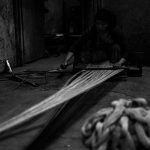To care for your 1970s acetate clothing, start by inspecting for damage and testing a small area with water. Hand wash gently in cool water using mild detergent, avoid scrubbing, and rinse well. Press out water without wringing and dry flat away from sunlight to prevent fading. Iron on low heat with a pressing cloth on the reverse side. Store in a dark, cool place using padded hangers and breathable bags to keep your vintage pieces pristine. Discover more tips to extend their life and look.
Table of Contents
Key Takeaways
- Hand wash 1970s acetate in cool water with mild detergent, avoiding scrubbing and soaking for 5 to 10 minutes.
- Gently press out water without wringing, then lay flat on a towel to air dry away from direct sunlight.
- Iron acetate on the reverse side using a low heat setting with a pressing cloth to prevent fabric damage.
- Store acetate garments in cool, dark, dry places using breathable cotton or muslin garment bags and padded hangers.
- Regularly inspect vintage acetate for stains, damage, or pests before cleaning or storage to maintain fabric integrity.
Understanding the Properties of 1970s Acetate Fabric
Acetate fabric from the 1970s has unique qualities that set it apart from other vintage materials. When you handle acetate, you’ll notice its smooth, silky feel and subtle sheen, which made it popular for stylish clothing back then.
Acetate fabric from the 1970s is smooth, silky, and subtly shining—perfect for vintage style lovers.
It’s lightweight and drapes beautifully, but it’s also quite delicate. You should know it’s sensitive to heat, which means ironing or washing with hot water can damage it.
Acetate tends to wrinkle easily, yet it doesn’t respond well to steam. It’s also prone to discoloration over time, especially if exposed to sunlight.
Understanding these traits helps you appreciate why acetate needs special care. By recognizing its sensitivity, you’ll avoid common mistakes and keep your vintage pieces looking great for years to come.
Preparing Vintage Acetate Garments for Cleaning
Before you clean any vintage acetate garment, take a few key steps to prepare it properly. Start by inspecting the fabric for any damage, stains, or weak spots. Handle the item gently to avoid causing further wear.
Next, check the care label for any specific instructions or warnings. Remove any detachable parts like buttons or pins to prevent damage during cleaning. Finally, test a small, hidden area with water to guarantee the fabric won’t react poorly.
Here’s a quick checklist to guide your preparation:
- Examine the fabric closely under good light
- Note any stains or delicate areas
- Read the garment’s care label
- Remove accessories and embellishments
- Perform a small water test on an inconspicuous spot
These steps set the stage for safe cleaning.
Hand Washing Techniques for Delicate Acetate Clothing
When you hand wash delicate acetate clothing, you’ll want to use cool water and a mild detergent to protect the fabric’s integrity.
Fill a basin with water and add a small amount of gentle detergent, stirring to dissolve it thoroughly. Submerge the garment and gently agitate it by moving it around without scrubbing or wringing, which can damage fibers.
Let it soak for about 5 to 10 minutes, then rinse thoroughly with cool water until all soap is removed.
Avoid twisting or wringing; instead, press the water out gently by pressing the fabric against the basin’s side. This careful approach prevents stress on acetate’s delicate fibers, helping your vintage piece stay in great shape.
Drying and Ironing Tips to Maintain Fabric Integrity
Although drying and ironing vintage acetate clothing requires extra care, following the right steps will help you preserve its texture and shine.
After washing, gently squeeze out excess water without wringing. Lay your garment flat on a clean towel to air dry, avoiding direct sunlight that could fade colors.
When it’s time to iron, use a low heat setting and place a pressing cloth between the iron and fabric to prevent damage.
Keep your acetate looking fresh with these tips:
- Dry flat on a towel to maintain shape
- Avoid twisting or wringing to prevent creases
- Use a low heat iron setting (synthetic or silk)
- Always iron with a pressing cloth
- Iron on the reverse side to protect the surface
Stick to these steps to keep your vintage acetate looking its best!
Long-Term Storage Solutions to Preserve Vintage Acetate
To keep your vintage acetate garments in pristine condition over time, you’ll need to store them properly to prevent damage from moisture, light, and pests.
Start by choosing a cool, dry, and dark place to avoid fading and mildew. Use breathable garment bags made of cotton or muslin instead of plastic, which traps moisture.
Hang your acetate pieces on padded hangers to maintain their shape and prevent creases. For folded storage, place acid-free tissue paper between folds to reduce friction and wrinkles.
Avoid overcrowding to allow air circulation and prevent crushing. Finally, regularly inspect your collection for any signs of pests or deterioration.
Taking these steps guarantees your 1970s acetate clothing stays vibrant and wearable for years to come.
Frequently Asked Questions
Can Vintage Acetate Clothing Cause Allergic Reactions on Sensitive Skin?
You might experience allergic reactions from vintage acetate clothing if you have sensitive skin, since older fabrics can contain residues or chemicals. Always test a small area first and consider using a protective barrier under the garment.
Is It Safe to Use Commercial Stain Removers on 1970S Acetate Fabric?
You might want to tread lightly with commercial stain removers on acetate fabric. They can be a bit too enthusiastic, potentially harming delicate fibers. Instead, try gentle, fabric-friendly options to keep your vintage piece looking its best.
How Can I Identify Authentic 1970S Acetate Clothing From Replicas?
You can identify authentic 1970s acetate by checking labels for fiber content, examining vintage stitching and wear, noticing fabric texture and sheen, and researching brand history. Replicas often lack genuine aging and specific design details.
What Are the Best Practices for Repairing Tears in Acetate Fabric?
Imagine a delicate silk flower—when tears appear, you’ll want to use fine, matching thread and tiny stitches. Gently hand-sew torn areas, avoiding tension, so your acetate fabric stays smooth and beautifully intact.
Can Vintage Acetate Garments Be Safely Dry Cleaned Without Damage?
You can safely dry clean vintage acetate garments, but make sure to choose a cleaner experienced with delicate fabrics. Always inform them about the fabric type to prevent damage and preserve your garment’s integrity and shine.
- The Use of Nonwovens in Construction and Civil Engineering - July 11, 2025
- The Use of Nonwovens in Construction and Civil Engineering - July 11, 2025
- The Use of Nonwovens in Construction and Civil Engineering - July 11, 2025







